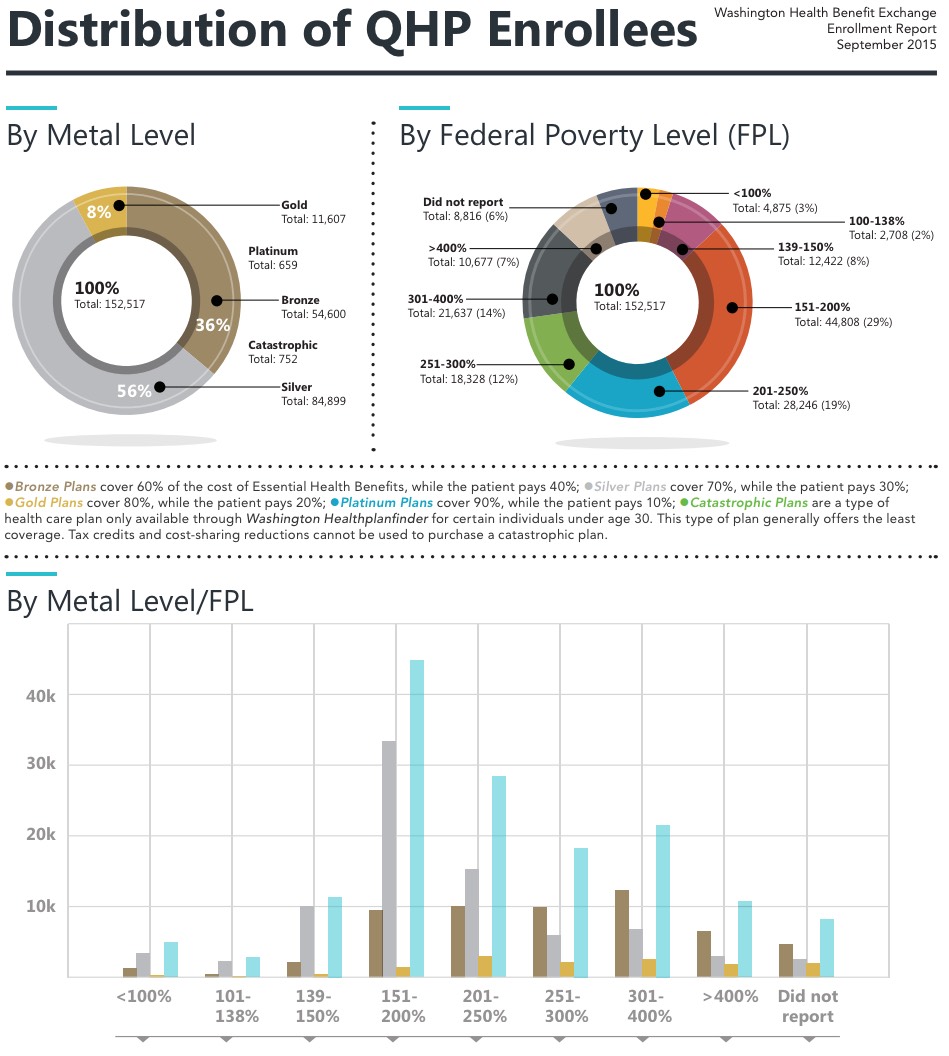Washington State releases VERY comprehensive, updated enrollment report w/tons of data
Fresh on top of the Covered California data drop, the Washington Health Benefit Exchange (the 3rd-largest state-based exchange after California and New York) has published an updated, detailed enrollment report:
The Washington Health Benefit Exchange, which operates the state’s insurance marketplace,Washington Healthplanfinder, today announced over 1.5 million Washingtonians accessed health coverage through wahealthplanfinder.org from Oct. 1, 2014 through Sept. 30, 2015.
The announcement was part of a new Health Coverage Enrollment Report that includes an updated enrollment total of 152,517 individuals in private health plans – called Qualified Health Plans (QHPs) – as well as executed enrollment for more than 1.4 million Washington Apple Health (Medicaid) eligible enrollees.
“These numbers demonstrate the effectiveness of the Exchange in providing opportunity for people to find health coverage that meets their needs and budget,” said Pam MacEwan, CEO for the Washington Health Benefit Exchange. “This past year is indicative of slower, incremental growth expected in the future as a result of the continued reduction in our state’s uninsured. We’re pleased with the number of individuals who continue to both access coverage through Washington Healthplanfinder and save money on their health insurance.”
The new report provides more detailed information regarding this year’s enrollees, including statistics on health insurance premiums and tax credit averages, enrollments by insurance company, figures related to those receiving one-on-one assistance as well as the metal level of the plan they selected.
Other data points of interest include:
- Average plan with a tax credit saved customers $207: The average monthly cost of a QHP with a tax credit was $173.89, while the average monthly cost for a plan without a tax credit was $381.15.
- 59,000 enroll in QHPs from January to May: Enrollments in QHPs grew by 59,002 in 2015 to more than 157,637 by May 1, a 37 percent increase.
- Nearly 30 Percent of QHP enrollees had individualized help: Nearly 30 percent of all enrollees in QHPs had in-person assistance from a certified assister or insurance broker.
- Young adult enrollment makes up 23 percent of QHP enrollment: Young adults age 18-34 made up 23 percent of total QHP enrollments. When accounting for Washington Apple Health enrollment, this number jumps to 27 percent of all enrollees.
As a reminder, those who qualify for Washington Apple Health may enroll at any point during the year, as well as American Indians/Alaskan Natives who are enrolled members of a federally recognized Tribe or an Alaska Native Corporation.
The Exchange is currently readying Washington Healthplanfinder for the 2016 open enrollment period that begins Nov. 1, 2015 and runs through Jan. 31, 2016. Letters have been sent to all current QHP customers with information about what to do to renew coverage. Customers can find more information at www.wahbexchange.org/renew.
A recent Gallup Poll estimated that Washington’s current uninsured level had plummeted from 16.8 percent in 2013, prior to the opening of the Exchange, to 6.4 percent. This 10.4 percent decline was the fifth highest drop in the nation and accomplished in only two open enrollment periods.
To view the detailed enrollment report, as well as corresponding data related to its findings, please visit our website. For more information about Washington Healthplanfinder and to enroll in health coverage, please visit www.wahealthplanfinder.org.
OK, that's actually around a 7% effectuated QHP reduction since June, which goes against the grain on my "QHPs are up" theory (6 other states have increased enrollment while Minnesota has dropped just 2% from June through September).
One thing they did not include in the report or accompanying PDF (filled with colorful graphs, pie charts and so forth, covering everything from metal level selections to age and income level) is a 2016 Open Enrollment projection number, which is kind of a bummer, but there's lots of data-nerdy goodness like this:




